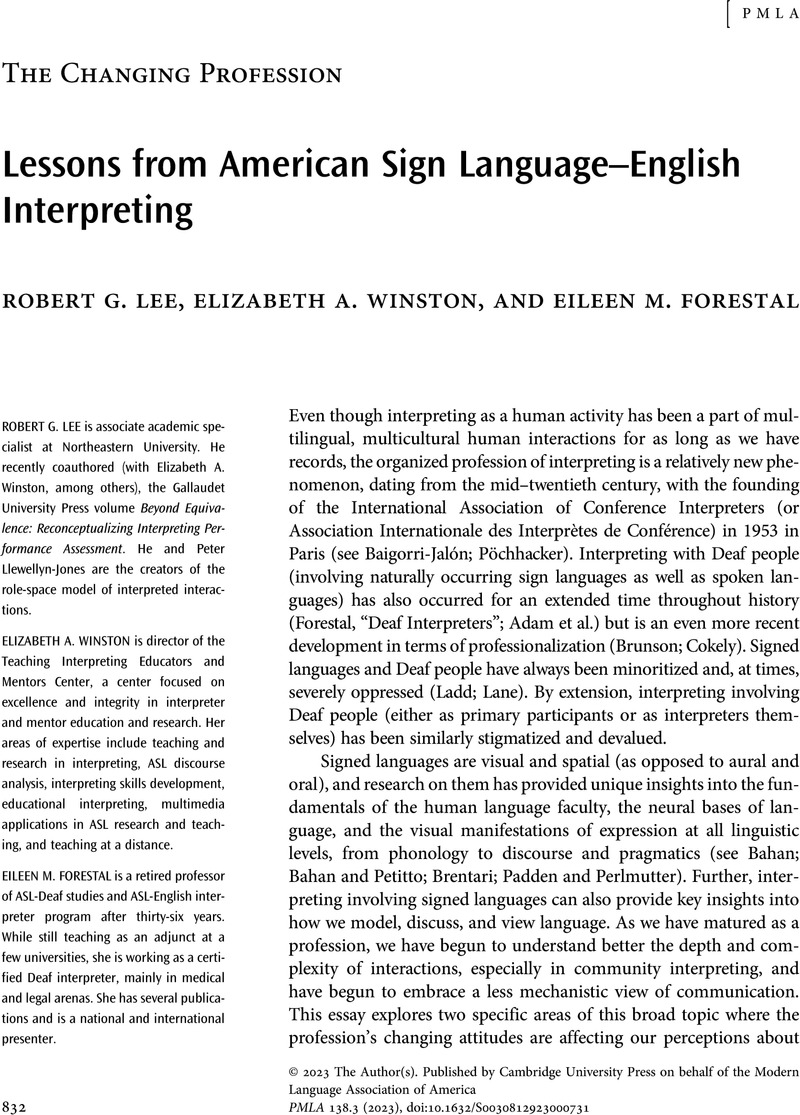No CrossRef data available.
Article contents
Lessons from American Sign Language–English Interpreting
Published online by Cambridge University Press: 12 September 2023
Abstract
An abstract is not available for this content so a preview has been provided. Please use the Get access link above for information on how to access this content.

- Type
- The Changing Profession
- Information
- Copyright
- Copyright © 2023 The Author(s). Published by Cambridge University Press on behalf of the Modern Language Association of America
References
Works Cited
Adam, Robert, et al. Deaf Interpreters at Work: International Insights. Gallaudet UP, 2014.CrossRefGoogle Scholar
Angelleli, Claudia. “The Visible Co-participant: Interpreter's Role in Doctor/Patient Encounters.” From Topic Boundaries to Omission: New Research in Interpretation, edited by Metzger, Melanie et al., Gallaudet UP, 2003.Google Scholar
Bahan, Benjamin. Non-manual Realization of Agreement in American Sign Language. 1996. Boston U, PhD dissertation.Google Scholar
Bahan, Benjamin, and Petitto, Laura. “Aspects of Rules for Character Establishment and Reference in ASL Storytelling .” 1980.Google Scholar
Baigorri-Jalón, Jesús. From Paris to Nuremberg: The Birth of Conference Interpreting. John Benjamins Publishing, 2014.CrossRefGoogle Scholar
Bélanger, Danielle-Claude. “Interactional Patterns in Dialogue-Interpreting.” Journal of Interpretation, 2004, pp. 1–18.Google Scholar
Bienvenu, Martina J. “Relay Interpreting.” Registry of Interpreters for the Deaf Conference, Aug. 1991, Bethesda, MD.Google Scholar
Brunson, Jeremy. “Sign Language Interpreting: Moving towards Professionalization.” Embodied Workers Conference, 2004, Syracuse, NY.Google Scholar
Cokely, Dennis. “Shifting Positionality: A Critical Examination of the Turning Point in the Relationship of Interpreters and the Deaf Community.” Sign Language Interpreting and Interpreter Education: Directions for Research and Practice, edited by Marschark, Marc et al., Oxford UP, 2005, pp. 3–28.CrossRefGoogle Scholar
De Meulder, Maartje, et al. “Describe, Don't Prescribe: The Practice and Politics of Translanguaging in the Context of Deaf Signers.” Journal of Multilingual and Multicultural Development, vol. 40, no. 10, Nov. 2019, pp. 892–906. Taylor and Francis Online, https://doi.org/10.1080/01434632.2019.1592181.CrossRefGoogle Scholar
Forestal, Eileen M. “Deaf Interpreters: Dynamics of Their Interpreting Processes.” Adam et al., pp. 29–50.CrossRefGoogle Scholar
Forestal, Eileen M. “The Emerging Professionals: Deaf Interpreters and Their Views and Experiences on Training.” Sign Language Interpreting and Interpreter Education: Directions for Research and Practice, edited by Marschark, Marc et al., Oxford UP, 2005, pp. 235–58.CrossRefGoogle Scholar
Furman, Sean. “A Conversation with CASLI.” Contentsharing.net, 2022, contentsharing.net/actions/email_web_version.cfm?ep=_txDTBVJgIa4dA82KZHAWnmHmhW8AY9X0-fgZOCJATzOn6K5KPicLXVxRVpAtKm1TC_-1uY1Okg16hDw8npA2SO0iutfMlZiO2WbhbAsr3gm1Kkjez_N0QZ9_bdm9KfW.Google Scholar
García, Ofelia, and Wei, Li. Translanguaging: Language Bilingualism and Education. Palgrave Macmillan, 2014.Google Scholar
Grosjean, François. Life as a Bilingual: Knowing and Using Two or More Languages. Cambridge UP, 2021.Google Scholar
Holcomb, Thomas K., and Smith, David H., editors. Deaf Eyes on Interpreting. Gallaudet UP, 2018. Project Muse, muse.jhu.edu/book/59211.CrossRefGoogle Scholar
Janzen, Terry, and Shaffer, Barbara. “The Interpreter's Stance in Intersubjective Discourse.” Sign Language Research Uses and Practices: Crossing Views on Theoretical and Applied Sign Language Linguistics, edited by Meurant, Laurence et al., Mouton de Gruyter, 2013, pp. 63–84.CrossRefGoogle Scholar
Janzen, Terry, and Shaffer, Barbara. The Shared Mind: Perspectives on Intersubjectivity. Edited by Zlatev, Jordan et al., John Benjamins Publishing, 2008, pp. 333–55.CrossRefGoogle Scholar
Ladd, Paddy. Understanding Deaf Culture: In Search of Deafhood. Multilingual Matters, 2003.CrossRefGoogle Scholar
Lane, Harlan. The Mask of Benevolence: Disabling the Deaf Community. Alfred A. Knopf, 1992.Google Scholar
Lee, Robert G. “Roles, Models and World Views: A View from the States.” Deaf Worlds, vol. 13, no. 3, 1997, pp. 40–44.Google Scholar
Lee, Robert G., et al. “Role Shift in ASL: A Syntactic Look at Direct Speech.” Syntactic Structure and Discourse Formation: An Examination of Two Constructions in American Sign Language, edited by Neidle, Carol et al., American Sign Language Linguistic Research Project / Boston U, 1997, pp. 24–45.Google Scholar
Lee, Robert G., and Llewellyn-Jones, Peter. Re-visiting Role: Arguing for a Multi-dimensional Analysis of Interpreter Behaviour. University of Central Lancashire, 2011, clok.uclan.ac.uk/5031/.Google Scholar
Llewellyn-Jones, Peter, and Lee, Robert G.. “Getting to the Core of Role: Defining the Role-Space of Interpreters.” International Journal of Interpreter Education, vol. 5, no. 2, 2013, pp. 54–72.Google Scholar
Llewellyn-Jones, Peter, and Lee, Robert G.. Redefining the Role of the Community Interpreter: The Concept of Role-Space. SLI Press, 2014.Google Scholar
McIntire, Marina L., and Sanderson, Gary R.. “Who's in Charge Here? Perceptions of Empowerment and Role in the Interpreting Setting.” Journal of Interpretation, vol. 7, no. 1, 1995, pp. 99–114.Google Scholar
Metzger, Melanie. “Constructed Dialogue and Constructed Action in American Sign Language.” Sociolinguistics in Deaf Communities, edited by Lucas, Ceil, Gallaudet UP, 1995, pp. 255–71.Google Scholar
Metzger, Melanie. Sign Language Interpreting: Deconstructing the Myth of Neutrality. Gallaudet UP, 1999.Google Scholar
Neidle, Carol, et al. The Syntax of American Sign Language: Functional Categories and Hierarchical Structure. MIT Press, 2000.Google Scholar
Padden, Carol A., and Perlmutter, David M.. “American Sign Language and the Architecture of Phonological Theory.” Natural Language and Linguistic Theory, vol. 5, no. 3, 1987, pp. 335–75.CrossRefGoogle Scholar
Reinhardt, Laurie. Swift Trust Formation: Experiences of Deaf Consumers and ASL-English Interpreters. 2021. Gallaudet U, PhD dissertation. ProQuest, www.proquest.com/openview/4e62feae8aed8fe5b2a43b4055f622a5/1?pq-origsite=gscholar&cbl=18750&diss=y.Google Scholar
Roy, Cynthia B. “The Problem with Definitions, Descriptions, and the Role Metaphor of Interpreters.” Journal of Interpretation, vol. 6, 1993, pp. 127–53.Google Scholar
Shaffer, Barbara, and Janzen, Terry. “Topic Marking: What Signers Know but Interpreters Don't.” Association of Visual Language Interpreters of Canada National Conference, Halifax, Nova Scotia, 22–26 July 2002.Google Scholar
Turner, Ralph H. “Role-Taking, Role Standpoint, and Reference-Group Behavior.” American Journal of Sociology, vol. 61, no. 4, 1956, pp. 316–28.Google Scholar
Wei, Li. “Moment Analysis and Translanguaging Space: Discursive Construction of Identities by Multilingual Chinese Youth in Britain.” Journal of Pragmatics, vol. 43, no. 5, 2011, pp. 1222–35.Google Scholar
Wilcox, Sherman, and Shaffer, Barbara. “Towards a Cognitive Model of Interpreting.” Topics in Signed Language Interpreting: Theory and Practice, edited by Janzen, Terry, John Benjamins Publishing, 2005, pp. 27–50.CrossRefGoogle Scholar
Winston, Elizabeth A. “Spatial Mapping in Comparative Discourse Frames.” Language, Gesture, and Space, edited by Emmorey, Karen and Reilly, Judy, Psychology Press, 1995, pp. 87–114.Google Scholar
Winston, Elizabeth A. “Spatial Referencing and Cohesion in an American Sign Language Text.” Sign Language Studies, vol. 73, 1991, pp. 397–409.CrossRefGoogle Scholar




